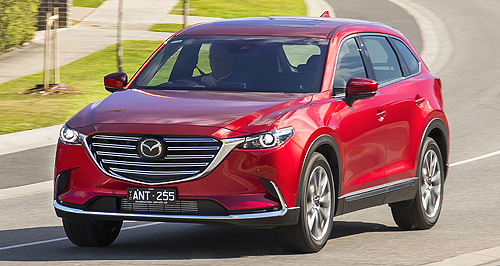News - MazdaLA show: Mazda rejects Genesis-style luxury marqueMainstream luxury: Mazda’s success with flagship variants of the CX-9 has heralded a further push into premium territory, bit don’t expect to see a premium Mazda sub-brand return. No Lexus-esque luxury brand but Mazda will push into premium territory4 Dec 2017 By BYRON MATHIOUDAKIS in LOS ANGELES MAZDA says it does not need to establish a Genesis-style luxury sub-brand, but has instead started a global push into premium territory with higher-specified models that will evolve with a greater emphasis on design, quality, engineering and customer satisfaction, at prices that are only slightly higher than key competitors. Buoyed by the a higher-than-expected take-up rate of the more expensive variants in models such as the CX-9 large SUV in key markets including North America and Australia, Mazda North American Operations president and CEO, Masahiro Moro, said he believed that buyers were now willing to pay more for Mazda-badged vehicles. “Up until four or five years I would say the majority of our customers come from mainstream brands, but over the last two or three years we particularly have seen the shift (to premium),” he told Australian journalists at the unveiling of the facelifted Mazda6 at the Los Angeles motor show last week. “And particularly when we introduced the CX-9 we have seen a lot of premium intenders and also premium customers come to buy our CX-9. It’s been just phenomenal. Mazda in the USA has never been successful selling cars costing more than $US35,000 in the past but CX-9 has been very good at selling $US45,000 models, and customers have come from Volvo, Jaguar and (companies selling) those cars costing $US50,000 to $US60,000. “To me it’s a little bit shocking, but those premium customers see Mazda as offering real value for money and they come to buy the (US range-topping) Signature (aligned with Azami in Australia) and GT variants. Those two top trim levels take 55 per cent share of total CX-9 volume, which is very high. And I see the same numbers with the new CX-5 which we launched earlier this year.” However, Mr Moro added that while Mazda is already perceived as being more premium than rivals such as Toyota and Honda in the SUV sphere, the company hoped to broaden that perception with its passenger-car line-up, beginning with the just-unveiled Mazda6 (due in Australia early in the third quarter of next year), and then followed by the Mazda3 small car sometime during 2019. “Honda and Toyota seem to be very similar, (providing) very good quality of non-premium vehicles,” he said. “US customers doesn’t recognise Honda as premium. Honda is a very good mainstream brand that they can rely on and have confidence in – and that is a strong point for Honda in the USA. And Accord is one great example of this. “As of today, the majority of cross-shopping between Mazda is Honda… so Mazda has to take a further step to differentiate from that mainstream, to provide unique value to our customers. So, where customers see the differences as of today and in the future is in great design, great craftsmanship, driving performance, and those are key differentiators against Honda. “Premium is a little bit confusing because everybody imagines a higher sticker price. Mazda premium is best at (keeping) long bonds with customers… who become loyal fans, enjoy their experiences and so are willing to pay a little more. That’s how customers find value in Mazda. That is the concept of Mazda premium – Mazda becomes special to the customer. “And of course, the passenger cars should be at the same level of the premium.” Mazda had planned to launch a luxury brand to take on Toyota’s Lexus and Honda’s (North America-only) Acura in the early 1990s globally with Amati Cars, but pulled the plug in the wake of the global recession in general and crippling Japanese economic downturn. Some of the planned upmarket models did spearhead a luxury-brand push under the Eunos nameplate in Australia from late 1992 with models such as the BMW 3 Series-bating 500 and 5 Series-rivalling 800, but Mazda’s mounting financial losses at the time had scuppered that by 1997.  Read more |
Click to shareMotor industry news |

















Facebook Twitter Instagram